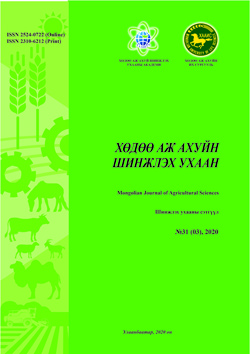Study of healing effects of the “Fomitop” gel on artificial burn wounds
DOI:
https://doi.org/10.5564/mjas.v31i3.1527Keywords:
Fomitopsis officinalis, silver sulfadiazine, histological analysis, wound healingAbstract
As a result of previous studies, we have established the “Fomitop” gel with extracts from the fungus Fomitopsis officinalis has antibacterial properties against some strains such as Staphylococcus aureus, Micrococcus luteus, Bacillus subtilis, and Enterococcus faecalis. Based on these results, we have conducted this research to identify the “Fomitop” gel has a healing effect on the burn wound. For this purpose, were conducted the comparative analysis of healing effects of the “Fomitop” gel with the standard ointment - silver sulfadiazine cream, on artificial burn wounds created on the back skin of a mouse. Total 27 Balb/c mice were included in the experiment and they are divided into three equivalent groups. In the first treatment, the group was applied to the “Fomitop” gel, the second standard group was applied silver sulfadiazine cream, and the third control group untreated by any ointment. On the 1, 5, 12, 21, and 35th days after wound creation, were taken the histological samples from the wound and near areas of the wound. The wound healing process was evaluated based on histological analysis. The burn wounds of the treatment group of mice (applied “Fomitop” gel) fully healed on the 33rd day of the experiment. While the wound healing rate of the standard group of mice (applied silver sulfadiazine cream) was 92.2% on the same day. And the control group mice wound healing rate was 78% (p<0.05). The results of the histological analysis were confirmed an active regeneration of epithelial cells and wound healing in the treatment group. It was good compared to the standard and control groups. As a result of this study, were determined the “Fomitop” gel application is accelerated the tissue regeneration of burn wounds and so on heals wound in a short time.
Фомитоп гелин түрхлэгийн түлэнхийн шарханд үзүүлэх үйлдлийн судалгаа
Бид өмнө гүйцэтгэсэн хар модны агил мөөгнөөс бэлтгэсэн “Фомитоп” гелин түрхлэгийн антибиотик төст үйлдлийг шалгах шинжилгээгээр Staphylococcus aureus, Micrococcus luteus, Bacillus subtilis, Enterococcus faecalis зэрэг бактерийн ургалтыг дарангуйлдаг болохыг илрүүлсэн. Уг үр дүнд үндэслэн “Фомитоп” гелин түрхлэг шархыг идээлүүлэхгүйгээр эдгээх боломжтой эсэхийг тогтоох энэхүү судалгааг гүйцэтгэв. Энэ зорилгоор “Фомитоп” гелин түрхлэгийг хулганы нурууны арьсанд үүсгэсэн химийн гаралтай түлэгдэлтийн зохиомол шарханд үзүүлэх нөлөөг стандарт эм болох мөнгөний сульфадиазин түрхлэгтэй харьцуулан судлав. Судалгаанд Balb/c үүлдрийн нийт 27 цагаан хулганыг тэнцүү тоогоор гурван бүлэгт хувааж хамруулав. Үүнд: 1-р бүлэг-агил мөөгнөөс бэлтгэсэн гелин түрхлэгийг хэрэглэсэн туршилтын бүлэг, 2-р бүлэг-мөнгөний сульфадиазин түрхлэг хэрэглэсэн стандарт бүлэг, 3-р бүлэг түрхлэг хэрэглээгүй хяналтын бүлэг. Шарх үүсгэснээс хойш 1, 5, 12, 21, 35 хоногуудад шарх, түүний ойр орчмын эдээс дээж авч гистологийн шинжилгээ хийж, шархны эдгэрэлтийг үнэлсэн. “Фомитоп” гелин түрхлэгийг хэрэглэсэн эмчилгээний бүлгийн түлэнхийн шарх туршилтын 33 дахь хоногт бүрэн эдгэрсэн бол мөнгөний сульфадиазин түрхлэг хэрэглэсэн стандарт бүлгийн шархны эдгэрэлт тухайн хоногт 92.2%, харин эм хэрэглээгүй хяналтын бүлгийн шархны эдгэрэлт нь 78% байлаа (p<0.05). Мөн гелин түрхлэг хэрэглэсэн бүлэг нь стандарт болон хяналтын бүлэгтэй харьцуулахад түлэнхийн шархны эдгэрэл, хучуур эсийн нөхөн төлжилт идэвхтэй явагдаж байгаа нь гистологийн шинжилгээний үр дүнгээр батлагдав. Судалгааны үр дүнд “Фомитоп” гелин түрхлэг нь түлэнхийн шархны нөхөн төлжилтийг хурдасгах, улмаар богино хугацаанд аниулах үйлдэл үзүүлж байгааг тогтоов.
Түлхүүр үг: Агил мөөг, мөнгөний сульфадиазин, гистологийн шинжилгээ, шархны эдгэрэл
Downloads
417
Downloads
Published
How to Cite
Issue
Section
License
Copyright on any research article in the Mongolian Journal of Agricultural Sciences is retained by the author(s).
The authors grant the Mongolian Journal of Agricultural Sciences a license to publish the article and identify itself as the original publisher.

Articles in the Mongolian Journal of Agricultural Sciences are Open Access articles published under a Creative Commons Attribution 4.0 International License CC BY.
This license permits use, distribution and reproduction in any medium, provided the original work is properly cited.




